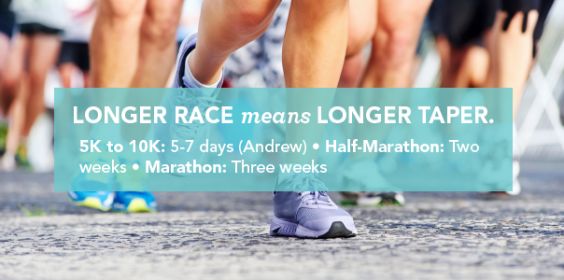It’s a moment many aspiring marathoners fantasize about as they finish their umpteenth long training run: The few weeks leading up to the race when a training program calls for less running and more recovery, otherwise known as the taper. As triathlete and Greatist expert Terra Castro explains, tapering allows your body to “repair, replenish, and regroup” in preparation for race day. But even though the break from an arduous training schedule can be appealing, it can also seem counterintuitive and even a little daunting to take time off. But a trustworthy taper—which is simple to execute with the guide below and the help of our experts—will have you healthy and strong for race day.
1. Duration: You Want Me to Stop Running for How Long?
According to Greatist experts Andrew Kalley and Jason Fitzgerald, the duration of the taper depends on the distance of the race. Kalley recommends tapering for five to seven days for races between 5K and 10K, with longer races like marathons and half-marathons requiring longer periods of recovery. Kalley advises those training forhalf-marathons and the full 26.2 taper for seven to 14 days.
2. Mileage: Less is More
A reduction in weekly mileage is crucial to every taper. The most common (and thought to be most effective) way to cut down is with a progressive taper, in which mileage is reduced every week until race day.
3. Intensity: Don’t Slow Your Roll
While dropping miles is integral to a good taper, it’s important that runners maintain training intensity.
4. Wellness: Treat Yourself
Tinkering with training is just one part of a taper. To get to the race start ready to conquer the course, consider activities that will keep your body and mind refreshed and relaxed like massages, stretching, foam rolling, ice baths, and acupuncture. Kalley, Fitzgerald, and Castro recommend getting adequate sleep and eating well during the taper period.
5. Pitfalls to Avoid: In Taper We Trust
The dueling temptations to rest too much and not rest enough can make for a tricky taper—it may feel strange to be running so much less than you have been. Castro recommends ignoring both “phantom pains” and “sneaky doubts.” Continue to trust the taper plan you put in place, knowing that reduced mileage, maintained intensity, and self-care are time-honored and science-approved ways to prepare for a race. Castro also warns against trying anything unfamiliar during this period, like a new pair of sneakers or a new workout group and routine. “Keep things simple and stress free in those taper weeks,” she says.

